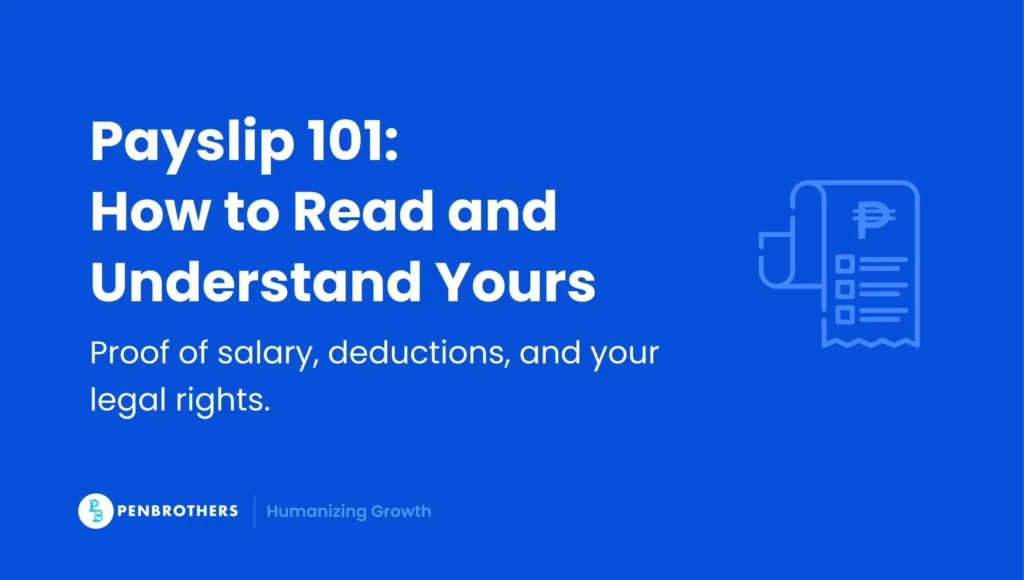A payslip is a vital document that details an employee’s earnings, deductions, and net pay. It ensures salary transparency and compliance with labor and tax laws. In the Philippines, payslip requirements are governed by DOLE labor advisories and the Labor Code, which mandate their issuance every payday, and the Bureau of Internal Revenue (BIR), which requires accurate tax reporting and record-keeping. Non-compliance with payslip requirements may result in DOLE sanctions and employee complaints, emphasizing the importance of accurate payroll documentation.
Key Takeaways
- A Legally Mandated Document for Transparency: In the Philippines, providing a payslip is a legal requirement mandated by the Department of Labor and Employment (DOLE). It serves as a vital document that details an employee’s earnings and deductions, ensuring transparency and compliance.
- Payroll is the Process, a Payslip is the Record: It is important to understand the distinction between the two terms. Payroll is the entire process a company uses to calculate and manage wages for all its employees. A payslip is the individual document given to a single employee, showing a specific breakdown of their pay for one period.
- A Compliant Payslip Must Be Itemized: A proper payslip must clearly itemize all components of an employee’s compensation. This includes gross income (basic pay, overtime), non-taxable income, all mandatory government deductions (SSS, PhilHealth, Pag-IBIG), the calculated withholding tax, and the final net pay.
- The Type of Worker Determines Who Issues the Payslip: Not all workers receive a traditional payslip from the company they perform tasks for. While regular employees do, freelancers and gig workers do not (they typically use invoices). Outsourced employees receive their official payslips from their third-party agency or Employer of Record, not from the client company.
What’s the Difference Between Payslip and Payroll?
A payslip is an individual document showing an employee’s earnings and deductions for a specific pay period. Payroll is the entire process and system companies use to calculate, manage, and distribute wages to all employees.
Think of payroll as the engine. It handles salary calculations, tax computations, government contributions, and payment processing. The payslip is the output, a detailed record of what each employee earned and what was deducted.
Payroll encompasses budgeting, compliance monitoring, and administrative tasks across your entire workforce. Your payslip is your personal financial record that proves your income and helps track your year-to-date earnings for tax purposes.
Payslip Compliance: DOLE & BIR Regulations
Pay slip compliance is not just about issuing documents. It’s about adhering to strict labor and tax policies that protect both employees and businesses.
DOLE Mandate
The Department of Labor and Employment (DOLE) requires employers to provide pay slips to employees each payday. These must clearly outline basic salary, overtime pay, deductions, and net earnings. Non-compliance can lead to employee complaints, fines, and legal action, emphasizing the importance of transparency in payroll processing.
Here’s an example of a pay slip that is compliant and how to read it:
- The Header
> Company Logo
> Pay Run: Payroll Disbursement Schedule
> Attendance: Timekeeping Cut Off
- Employee Details
> Employee Name
> Employee ID
> Hire Date
> Government Mandated Numbers
> Position
- Year-to-Date Figures
Year-to-date (YTD) figures refer to the cumulative totals of employees’ various earnings and deductions from the beginning of the current calendar year up to the present date.
Taxable Income: Year-to-date figures of the taxable income
Non-Taxable Income: Year-to-date all the De Minimis Benefit and other allowable earnings are deducted from the Gross Income.
Gross Income: Year-to-date total income before taxes which includes basic pay, overtime, and other allowances.
SSS EE: Year-to-date figures of the total SSS Employee Share
HDMF EE: Year-to-date figures of the total Pagibig Employee Share
PHIC EE: Year-to-date figures of the total Philhealth Employee Share
WTAX: Year-to-date figures of the total Tax withheld
Other Deductions: Year-to-date figures of deductions such as Statutory Employee and Employer Share, Withholding Tax, Loans, HMO deductions, etc.
Net Pay: Year-to-date figures of the total take-home pay
- Gross Income
The gross income is your total income before taxes which includes the basic pay, overtime, and other allowances.
Here are the most notable changes:
Basic Pay:
Before: The amount labeled as “basic pay” was actually the total pay indicated in the contract (basic pay + de minimis).
After: The amount labeled as “basic pay” now accurately reflects the actual basic pay. De minimis benefits are now enumerated separately below the basic pay, along with other additional pay such as overtime and night differential.
- Non-Taxable Income
The Non-Taxable Income which includes all the De Minimis Benefit and other allowable earnings is deducted from the Gross Income.
- Mandatory Deductions
Government-mandated benefits such as SSS, Philhealth, and PAGIBIG employee share.
- Taxable Income
Taxable Income = Gross Income – Non-Taxable Income
- Withholding Tax
It is required to withhold a certain percentage of the employee’s compensation, based on the standard withholding before disbursing the remaining amount to the payee.
- Deductions
Includes loans, HMO, and other deductions
- Net Pay
The total amount of take-home pay.
- Hours and Remarks
The automated hours shown on the pay slip are based on the employee’s complete time logs, while the manually entered remarks correspond to assumed NDs and approved OTs.
BIR Tax & Record-Keeping Rules
Pay slips must align with BIR tax regulations, ensuring that withholding taxes are properly computed and documented. Companies must maintain payroll records according to BIR requirements, typically for several years to support tax compliance and potential audits. Accurate payroll documentation safeguards businesses against tax audits and legal repercussions, reinforcing financial integrity.
What Is the Pay Period on a Payslip?
The pay period indicates the specific timeframe your payslip covers, typically the dates when you worked to earn that payment. In the Philippines, most companies use bi-monthly periods (15th and 30th) or monthly cycles.
Your payslip shows both the pay period (work dates) and the pay date (when you receive payment). For example, if you worked January 1-15, your payslip might show “Pay Period: Jan 1-15, 2025” and “Pay Date: Jan 20, 2025.”
Understanding pay periods helps you track overtime, absences, and prorated salaries for partial months. It’s also essential for tax reporting since your annual income calculation depends on accurate pay period documentation.
Pay Slips for Different Employment Types
Not all employees receive the same type of pay slip. Understanding how different employment categories affect pay slip issuance is crucial for accurate payroll processing.
Regular vs. Contractual Employees
Regular employees receive pay slips reflecting government-mandated deductions, such as SSS, PhilHealth, and Pag-IBIG contributions. Contractual or project-based workers may have varying tax deductions, depending on employment duration and contract terms. Employers must clearly indicate these differences to avoid payroll disputes.
Freelancers, Gig Workers & Outsourced Employees
Unlike traditional employees, freelancers and gig workers do not receive employer-issued pay slips. Instead, they must secure alternative proof of income, such as invoices or remittance statements. For outsourced employees, pay slips are issued by the contracting agency, ensuring payroll compliance under Philippine labor laws.
Remote Workers with Global Employers
Remote employees working for foreign companies may receive pay slips from their overseas employers. However, if these employees are registered taxpayers in the Philippines, their income must comply with local tax laws. Employers and workers alike must be aware of cross-border tax obligations to avoid legal complications.
Digital Pay Slips & Payroll Automation
With the shift toward digital transformation, electronic pay slips are becoming the norm. Employers must ensure compliance while leveraging technology for efficiency.
Legal Validity of E-Pay Slips
The shift toward digital payroll is gaining traction. DOLE allows electronic pay slips as long as they are accessible, verifiable, and secure. Employers must ensure that e-payslips comply with data privacy laws and are readily available to employees upon request.
Common Pay Slip Issues & Payroll Disputes
Errors and disputes related to pay slips can lead to employee dissatisfaction and potential legal issues. Addressing these concerns proactively can help maintain a healthy work environment.
Payroll Errors
Incorrect deductions, overtime miscalculations, and missing allowances are common payroll errors. These mistakes can lead to employee dissatisfaction and potential labor disputes, making it crucial for businesses to implement robust payroll verification processes.
Fake Pay Slips & Fraud
Pay slip fraud is a rising concern, with fabricated documents being used for loan applications, visa approvals, and credit verification. Employers must implement anti-fraud measures, such as digital pay slips with security features, to combat this issue.
“No Payslip, No Pay” Disputes
Some employers withhold salaries due to administrative lapses in pay slip issuance. However, DOLE strictly prohibits this practice. Employees are entitled to their wages, regardless of pay slip availability, reinforcing the importance of efficient payroll management.
How Do I Check My Payslip Online?
Most companies now provide digital payslip access through employee portals or HR management systems. Check with your HR department about your company’s specific platform and login credentials.
Common ways to access your online payslip include company intranets, dedicated payroll software like BambooHR or Workday, or email delivery systems. You’ll typically need your employee ID and a secure password to log in.
For outsourced employees, your staffing agency or employer of record handles digital payslip distribution. Contact your account manager if you can’t access your online payslip or need technical support with the platform.
Resolving Pay Slip Errors & Disputes
Addressing payroll disputes effectively prevents prolonged legal battles and ensures workplace harmony.
Preventing Payroll Issues
To prevent disputes, employers must adopt clear payroll policies, conduct regular audits, and provide accurate pay slips. Transparent payroll processes build trust, reduce conflicts, and improve employee satisfaction.
Understanding your pay slip is essential, but so is knowing how your salary should be structured. Check out the 2025 Penbrothers Philippine Salary Guide to ensure you’re being paid fairly.
Employer’s Guide to Payroll Compliance
Ensuring payroll compliance protects businesses from financial risks and enhances employee trust.
DOLE & BIR Compliance Resources
Employers must stay updated on labor and tax regulations by referring to DOLE advisories and BIR guidelines. Keeping up with compliance updates ensures smooth payroll management and prevents costly penalties.
Automate & Stay Compliant
Payroll errors and compliance lapses can be costly. By adopting compliant payroll systems, businesses can streamline processes, reduce risks, and ensure seamless pay slip management. Employers must act now to stay compliant and protect their workforce.
Frequently Asked Questions
Payroll is the entire company-wide process of calculating, managing, and distributing employee salaries. A payslip is the individual document or record given to a single employee that provides a detailed breakdown of their specific earnings and deductions for a particular pay period.
Yes. The Department of Labor and Employment (DOLE) legally requires all employers in the Philippines to provide a payslip to their employees on every payday. Failure to do so can result in sanctions and employee complaints.
The mandatory deductions that must be itemized on a payslip include the employee’s share for government contributions to the Social Security System (SSS), the Philippine Health Insurance Corporation (PhilHealth), and the Pag-IBIG Fund (HDMF), as well as the withholding tax that is calculated based on their taxable income.
No. Freelancers are considered self-employed and issue their own invoices; they do not receive employer-issued payslips. Outsourced employees receive their official payslips from their legal employer, which is the outsourcing agency or Employer of Record (EOR), not the client company they are assigned to.
You should immediately report the issue to your company’s HR or payroll department so they can investigate and correct the error. If the issue is not resolved, you can seek assistance from the Department of Labor and Employment (DOLE), as employers are legally required to provide accurate compensation.






